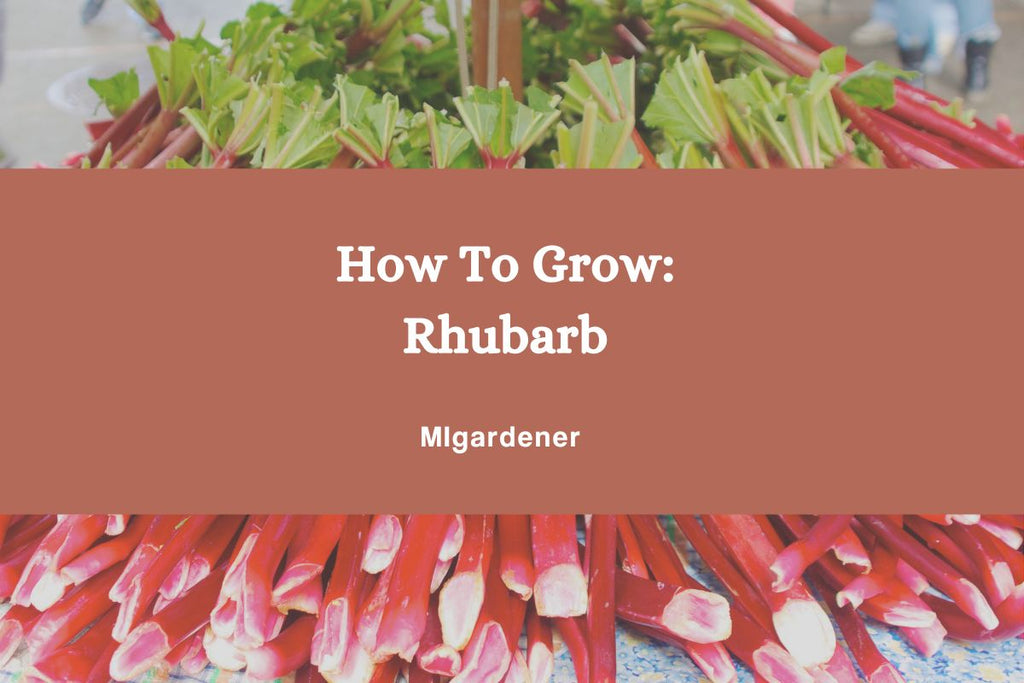
Complete Guide to Growing Rhubarb
Who doesn't love the sweet and tart flavor of rhubarb? The giant leaves, and beautiful deep red stems. Surprisingly enough, rhubarb isn't very hard to grow. In this blog post I will go through how to grow it from start to finish.
Location: Rhubarb prefers a cool, moist environment, so choose a planting location that gets partial shade and has well-draining soil. Avoid planting in areas that are prone to flooding or have heavy clay soil. Prepare the location by adding compost or aged manure to improve soil fertility and structure. Rhubarb plants also prefer a slightly acidic soil with a pH between 6.0 and 6.8.

Planting: Generally, rhubarb is planted from smaller roots that have been divided off from a main plant, however seeds can also be used. Seeds take a bit more time from planting until harvest, but are more economical. If starting from a small crown, plant in early spring as soon as the soil is workable. Dig a hole that's deep enough to accommodate the plant's root system, and plant the crown (the fleshy base of the plant) so that the top of the crown is just above the soil level. It is VERY important not to bury the crown. This can cause a disease known as crown rot. Space the plants about 3 feet apart.
Care: Rhubarb is a relatively low-maintenance plant, but there are a few things you can do to ensure it stays healthy and productive. In the fall, cut back the dead foliage to the ground, and add a layer of compost or aged manure around the base of the plants. Rhubarb can also be divided every 4-5 years to keep the plants from becoming too crowded.
If you want more harvest larger stalks, and earlier, try a method called blanching. This is the process of taking a clay pot, or something that will block sunlight, and covering them in early season. It will cause the plants to stretch and offer you a better harvest. The amount of time you blanch a crop depends on the desired result, generally 1-3 weeks. If a plant is kept covered for too long however, it can kill it by preventing photosynthesis.


Watering: Water newly planted rhubarb regularly, up to 3 times a week if needed. Getting plants established is key. Once they are established, plants will be more self sufficient and not require much watering beyond what they get from regular rainfall. Their lack of maintenance is due to the large deep burrowing roots that penetrate deep into the soil up to 2 feet deep! This not only finds lots of nutrients and water, but also ensures the plant will come back year after year

even after the coldest winters.
Fertilizer: Rhubarb doesn't require a lot of fertilizer, but you can add a balanced fertilizer (such as a 10-10-10), we use Trifecta+ in the spring and again in the fall. The thick deep roots do a great job of sourcing nutrients deep in the soil otherwise many plants are unable to obtain.
Mulch: Mulch around the base of the plants with a layer of organic material such as straw or shredded leaves. This will help retain moisture in the soil and suppress weed growth.
Harvesting: You can begin harvesting rhubarb in its second year of growth. Only harvest the stalks, leaving the leaves behind.To harvest, grasp the stalk near the base and pull it away from the plant with a gentle twist. Cutting the plant with a knife is also a great way to harvest. Be careful to just harvest red stalks, and be careful to not cut into the crown of the plant.

If your rhubarb suddenly disappears, rhizome and all, chances are you have voles. I have lost multiple huge rhubarb plants to voles through the years.
I am in zone 7A and had same issue as you for years. At least four times I had beautiful rhubarb the first year and then nothing. An old farmer told me that to grow rhubarb in this area it needs to be started from seed. I did that and have had the most beautiful rhubarb for more than four years. Another farmer friend had same issue with starter plants, but now has huge rhubarb bed that he started from seed. Divisions from seed started rhubarb in your area work well also.
@Kathy
Kathy, it is my understanding that the crown requires a below freezing temp for a period of time for regrowth in Spring. So I guess you’re right in that it is an annual internship South and a perennial in the North.
Over the past 5 years I have grown a beautiful rhubarb plant but it has never developed red stalks. They are white to pale green. Is this really rhubarb? Can it be eaten if it is? Should I forget it and plant a new plant?
Leave a comment